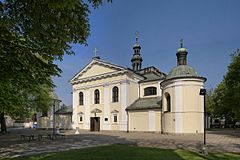Church of Our Lady of Loreto
| Loreto Church | |
|---|---|
 |
|
| General information | |
| Architectural style | Baroque |
| Town or city | Warsaw |
| Country | Poland |
| Construction started | 1640 |
| Completed | 1642 |
| Demolished | 1944 |
| Design and construction | |
| Architect | Constantino Tencalla |
The Church of Our Lady of Loreto (Polish: Kościół Matki Boskiej Loretańskiej) is an ornate church in Praga, a district of Warsaw, Poland, on the east bank of the Vistula River. The church stands on Ratuszowa (City Hall) Street and is Praga’s oldest monument. What may be seen today is a former chapel that on its south side was once attached to a baroque church and a Bernardine (Minor Friars) monastery.
A chapel is all that remains of the old building that used to stand adjacent to the Bernardine church and monastery. On 4 October 1617 the cornerstone of the baroque church was laid in the presence of King Sigismund III Vasa. The St. Andrew's church was constructed between 1628 and 1638.
The Loreto Chapel was built between 1640 and 1642, in the southern part of the shrine. The construction was financially supported by King Władysław IV Vasa and Queen Cecilia Renata. Other members of the royal family, especially king's brothers, also participated in the construction. The chapel was built according to design by Royal architect Constantino Tencalla and modelled after Basilica della Santa Casa by Donato Bramante and Andrea Sansovino. Tencalla adjusted the original renaissance design to the baroque forms.
The copy of Mary’s house, so-called Loreto house, was placed inside the chapel. According to legend the Loreto house was transported by angels from the Holy Land to Croatia, and later to the Italian town of Loreto in about 1294. Inside a small room of the chapel the statue of Virgin Mary of Loreto, brought from Italy at the king’s initiative, was arranged. In 1641 Queen Cecilia Renata established golden crowns for the statue. The solemn consecration of the chapel occurred in 1642.
...
Wikipedia
